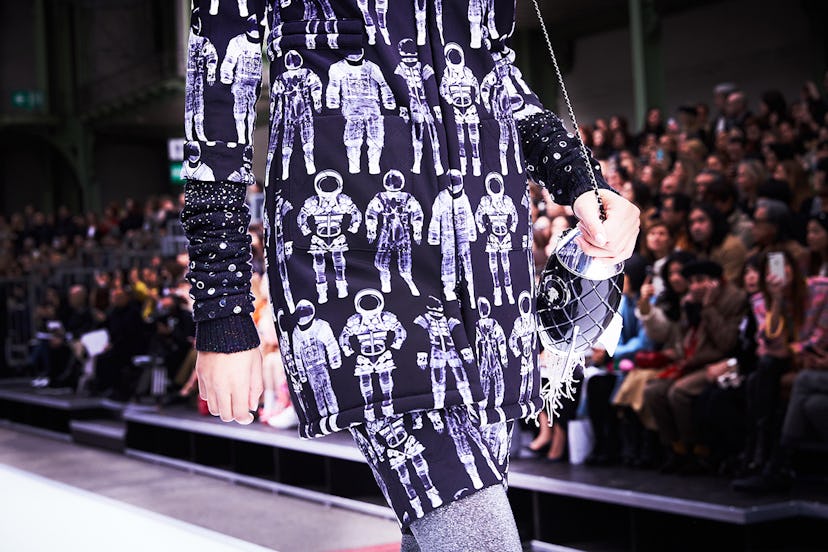If Isaac Newton were alive today, he might have come up with a fourth law of motion just to deal with fashion trends, which seem to defy all existing rules by moving forwards and backwards at the same time. Fashion is supposed to take us into the future, but wait long enough and yesterday’s trends will come back eventually, some returning faster than others.
In 2017, for example, we’re seeing the return of Paco Rabanne’s signature metallic chain-metal dresses, which first walked the runways in the 1960s, and were “in” again in the early-aughts during Paris Hilton’s heyday. Now, they can be found in Paris nightclubs on twentysomethings like Bella Hadid. To boot, white go-go boots are back as well—a trend that similarly took off in the ’60s along with Space Age style, starting with André Courrèges and was later recycled during the Studio 54 era. Now, they’re back with the help of brands like Balenciaga. (And Hadid too, of course.)
As with the constellations, drawing lines between reoccurring trends can help make sense of where we come from, how we ended up here, and where we might be headed. And fittingly, all roads lead to outer space at the moment, from Chanel’s rocket launch on the runway to Christopher Kane’s cosmic prints.
Plus, Kanye West’s next project is potentially space-related, as a mysterious website recently surfaced featuring a video called, “NASA Kanye West Project 10,” which is mostly static save for an image of an old NASA Jet Propulsion Lab logo. (Coincidentally, the NASA Jet Propulsion Lab is about an hour away from West’s headquarters in Calabasas, California.)
As illustrator Marisa Marchetto outlined in her column, fashion is frankly obsessed with the subject of space in 2017.
But why now? Again? Let’s start from the beginning.
The Space Age trend began in the mid-to-late ’60s with designers like Courrèges, Rabanne, and Pierre Cardin, who were inspired by the global space race. (The Soviets landed in 1959, and Buzz Aldrin, who is featured in Marchetto’s column, natch, took his historic first step in ten years later.) In fact, Courrèges demonstrated such an interest in the future of space travel, that he received a personal invitation from NASA to come visit Cape Canaveral in Florida. Around the same time, Rabanne also designed the costumes for Barbarella, a sci-fi film starring Jane Fonda, who plays a member of the “United Earth government” sent to space in the “41st century” to find an evil scientist plotting to end humanity. Side-by-side, one might mistake Barbarella for Gucci’s fall 2017 post-apocalyptic warrior.
Jane Fonda as Barbarella in 1968.
In the ’60s, Space Age style revolved around the idea of exploration—of pushing boundaries further than ever before, whether that meant with materials or silhouettes. It truly felt new and exciting because the “future” everyone imagined of flying cars and men on the moon was still far off. Anything was possible. However, it also grew out of an underlying fear fueled by the ongoing Cold War, one that we can perhaps relate to today with Russian hackers influencing the election and talk of fake news.
It is not a coincidence that Space Age style is returning at a time when global politics are so unstable, from Brexit to the refugee crisis to Donald Trump being elected President of the United States. It’s fashion’s function to reflect the times, but also to look forward at a better, chicer, more interesting future. And unfortunately for us, designers don’t seem to think that can be found, or not on earth anyway. According to fashion designers, we either have to adapt to living in a Gucci green house or leave the earth behind entirely; blow ourselves up, or admit that we’ve run out of ideas. Whichever comes first.
Andre Courreges circa 1965.
It’s a certainly a bleak vision for an industry that thrives on escaping reality. But perhaps the times have forced fashion to become more practical. If the end of the world is nigh, why not design a chic hazmat suit, like the young Chinese men’s wear designer Shangguan Zhe of Sankuanz did this season?
Or rather, on a more optimistic note, if tech innovators like Elon Musk are making life on another planet seem less like a Hollywood movie and more like a possibility in the not-so-distant future, then fashion innovators like Karl Lagerfeld have to start thinking this way, too. If there’s one thing that a brand cannot do, it’s be left behind.
So, designers are certainly taking the right steps towards a fashionably sustainable future, but are we doing enough to make the necessary giant leap?
The spectacle of Chanel’s fall 2017 show, which ended with a rocket “launching” through the glass ceiling of the Grand Palais, was the perfect metaphor for the direction fashion (and perhaps culture at large) is currently heading: Nowhere fast, despite appearances.
This season, designers offered escapist fantasies for a world critically devoid of shimmer. And for this, we thank them. But, at the end of the day, our imaginations can only transport us so far. And moving to Canada, let alone Mars, is also not the best laid plan. Rather, we’ve got to treat planet like a great trend—don’t give up on it just yet.
Butterflies of Paris: How Street Style Stars Do Paris Fashion Week
